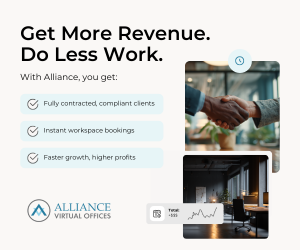Written by Steve Eveleigh, Chief Marketing Officer at essensys
The commercial real estate market has undergone a massive shift over the past few years. Coincidentally, the coworking market has matured after experiencing rapid growth and uptake across various sectors.
According to The Instant Group’s recent Global Cities report, the amount of flexible workspace across the globe has increased by 18% in the past 12 months. Traditional office leases have become a thing of the past, and CREs are modifying how they utilize their property assets.
The Indications
For starters, coworking has moved beyond being a trend, a “revolution” or a “movement” as many referred to it in its initial days. The early adoption stage is complete and, in retrospect, coworking may even be considered the evolution of the serviced office, as evolved from business or executive centers that popped up in the 70s.
Coworking may even be considered the evolution of the serviced office, as evolved from business or executive centers that popped up in the 70s.
The demand for shared workspace and rapid uptake of coworking by corporates are proving the viability of the business model and legitimacy of coworking and workspace-as-a-service as a rentable business venture for all stakeholders.
This summer we saw the entrance of new market players flexing their muscles. All signs point to market maturity when longtime workspace operators are no longer driving the industry forward, and large asset holders and investment companies put their stake in the ground.
Blackstone, the largest real estate private equity firm in the world managing $102 billion of assets, announced their acquisition of London’s The Office Group. With a portfolio of 36 buildings, the acquisition gives The Office Group the impulse they need to globalize their brand. Meanwhile, the US-based private equity fund Carlyle purchased three London buildings to bring a new brand Uncommon to London, a predominant market for flexible workspace.
These new entrants to the market demonstrate a stronger capitalization on once long-term commercial real estate transactions. More broadly, the marked increase in financial investment in flexible workspace and Coworking will be something to keep an eye on over the upcoming months. Here’s what we can expect:
These new entrants to the market demonstrate a stronger capitalization on the once long-term commercial real estate transactions.
The Implications
1. Faster-paced Market Growth
Where commercial real estate was traditionally a long-term asset on the books, with long transactions and a fixed approach to managing the property, the shift today is to a more short-term holding that allows for flexibility to change with trends.
2. Flexibility in Asset Utilization and Cross-Market Movement
Taking a stake in flexible workspace CRE and equity firms can capitalize on new and existing varieties of real estate assets in the form of space-as-a-service. They can expand their property portfolio while gaining access to new industries and markets, and even take their brand global without the painstaking effort of breaking into a new market. As an example, the recent news on China’s predominate coworking brand UrWork’s expansion to the US market.
3. Profit over Community
As the market continues to mature, the focus shifts from building community to increasing occupancy and profitability. It becomes less about end-users buying into the workspace offering and concept as it is about fitting your model to meet user needs and exceed member expectations.
The focus shifts from building community to increasing occupancy and profitability.
4. Capitalizing on Space Assets
Commercial real estate players and asset owners will jump on the band wagon and take advantage of a colossal opportunity to monetize property assets sitting on their books. From their perspective, renting real estate to a coworking operator at $50 per square foot and then seeing it re-leased at double the price by the tenant is a compelling enough reason to get in the game.
5. Cutting out or Hiring the Middle Man
CREs taking their piece of the pie may be a double-edged sword for existing shared workspace operators. On the one hand, property owners who grasp the coworking model and can master the approach do not need to employ an expert to manage their space. With the right fit out and infrastructure and skeleton team, CREs may attempt to cut out the middle-man, leaving operators struggling to compete with the new competition. Alternatively, their knowledge and mastery of coworking can be used to their advantage to consult CREs on how to open, fit-out and manage a workspace.
Their (operators) knowledge and mastery of coworking can be used to their advantage to consult CREs on how to open, fit-out and manage a workspace.
6. Innovative Ventures
As noted in this year’s GWA Financial Industry Survey results, increasing rental rates will drive existing operators and lessees to approach landlords and property owners with new and creative joint-ventures and lease negotiations. With the goal of establishing a recognizable brand and stellar member experience, future engagements between landlords and managers will forge new ways of approaching the operator model.
As the coworking model continues to mature and the market fluctuates, workspace operators will experience a lasting impact on their ability to fend off new commercial competition. As part of an ongoing initiative to lead and serve the market, essensys encourages all operators to complete the first annual Worldwide Workspace Survey. Contribute your response and help to project the future of the market for operators and owners of shared workspaces.


 Dr. Gleb Tsipursky – The Office Whisperer
Dr. Gleb Tsipursky – The Office Whisperer Nirit Cohen – WorkFutures
Nirit Cohen – WorkFutures Angela Howard – Culture Expert
Angela Howard – Culture Expert Drew Jones – Design & Innovation
Drew Jones – Design & Innovation Jonathan Price – CRE & Flex Expert
Jonathan Price – CRE & Flex Expert












